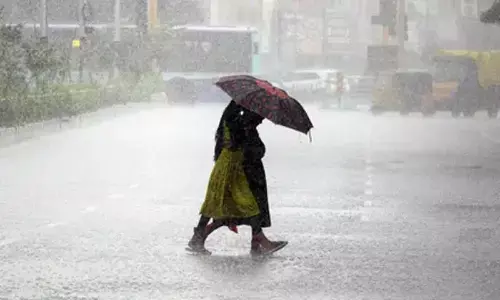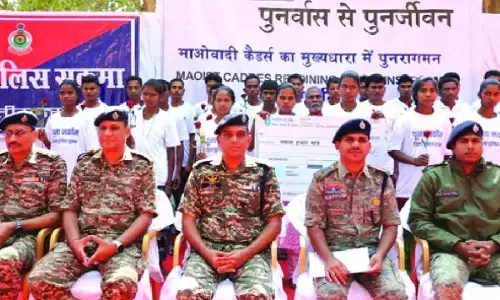Women increasingly becoming drivers of economic growth

Women increasingly becoming drivers of economic growth
In banking sector, many women have broken glass ceiling
Women's contribution to the economic development of any country is enormous. The only difference is that the role of men is highlighted and that of women tends to remain unknown. In agriculture, for instance, much is being talked about farmers, but it was only on Women's Day that women farmers held a special demonstration as part of the current agitation on Delhi's borders.
Similarly, there are large numbers of women in the industrial workforce, but little is known about their role in making sure factory operations run smoothly. There are some role models, however, that one cannot overlook and underline the fact that women are increasingly becoming drivers of economic growth.
One such person is Ela Bhatt who set up the Self-Employed Women's Association (SEWA) in Gujarat that has gone on to become a template for women's cooperatives. The formation of women's cooperatives and self-help groups throughout the country has also become a testament to the fact that women are efficient at repaying loans as also in making their associations work efficiently.
At the other end of the spectrum is billionaire entrepreneur Kiran Mazumdar Shaw who demonstrated that a woman can set up a successful business venture based on bio-technology. There are other women in industry, but many are not rated highly simply because they are scions of entrenched business houses.
This is strange given that most men heading these large conglomerates are also part of business dynasties. Yet these well-known persons are given their due as corporate change-makers.
One segment of the economy that has fortuitously had many women breaking the glass ceiling is the banking sector. Many women have been heads of private-sector banks including Naina Lal Kidwai, Kalpana Morparia, Renuka Ramnath and Shikha Sharma.
In the public sector, it was left to Arundhati Bhattacharya to become the first head of the State Bank of India (SBI). One of her lasting gifts to women working in the SBI was a two-year sabbatical leave policy for female employees to be used either for maternity or elder care. She also launched free vaccination against cervical cancer to all the bank's female employees.
While this is all good news, as far as the bulk of women's employment is concerned, there is considerable worry over the fact that female labour participation in the workforce has gradually declined over the past three decades.
Female labour force participation (FLFP) fell from 30.3 per cent in 1990 to 20.5 per cent in 2019, according to World Bank data. In the case of men, however, it declined from a high of 84 per cent to 76.8 per cent. The reasons for this sharp fall in the case of women have not yet been accurately identified.
It is presumed that one reason could be greater number of years spent in being educated and acquiring more skills. Another possibility could be that more women are being employed in the informal sector for which there is no accurate data available.
The situation has worsened during the pandemic.
The Centre for Monitoring Indian Economy (CMIE), which does regular studies on unemployment has found that the FLFP for urban women fell to 6.9 per cent in November last year. This may have improved over the last few months, but indicates a worrisome trend as urban women are expected to find greater job opportunities than in rural areas.
As far as the rural and agriculture sector is concerned too, it has to be accepted that women do as much work in the fields as men. In addition, they also do household chores, making their burden even greater.
Research studies have shown that women's share of work on farms ranges from 33 to 50 per cent of the total manual work, though organic farming puts greater strain on women than conventional modes of farming.
It is interesting to note that the government has actually described the increasing role of women in this sector as the 'feminisation' of agriculture in a special note on this issue in the Economic Survey of 2017-18. This was attributed largely to the increase in migration to urban areas.
As a result, women took on multiple roles as cultivators, entrepreneurs and labourers. In fact, the Survey notes that globally there is empirical evidence that women have a decisive role in ensuring food security and preserving local agro-biodiversity.
Not only those rural women are now responsible for the integrated management and use of diverse natural resources to meet daily household needs. It was thus felt that the gender-based differentiation towards access to land, water, credit, technology and training needed to be addressed in some way. The positive aspect of this analysis is that policies are now being framed to improve the entitlements of women farmers.
While a great deal needs to be done to improve the status of women in the rural areas, urban areas have been shown greater penetration of women in the educated and highly skilled categories.
Increasing numbers of women are seeking to enter technical areas like engineering and science as well as management. In addition, women are gradually entering into the arena of startup ventures though as yet men continue to dominate this space.
A study by the Reserve Bank of India (RBI) found that only 5.9 per cent of women were the sole founders of startup ventures in 2018-19. At the same time, many women have been co-founders of startups along with men and several of these have been successful.
The biggest unicorn right now headed by a woman is Nykaa, which is growing by leaps and bounds during the pandemic as the demand for online cosmetics grew exponentially.
The role of women in business and the economy is thus rising rapidly over the past few decades.
Some issues, however, need to be examined in detail such as the decline in FLFP as well as according women farmers an equal status in terms of access to resources. Women's Day on March 8 every year thus comes as an annual reminder that women of the country have come a long way since independence, but there is still a long road ahead to achieve their full potential.















